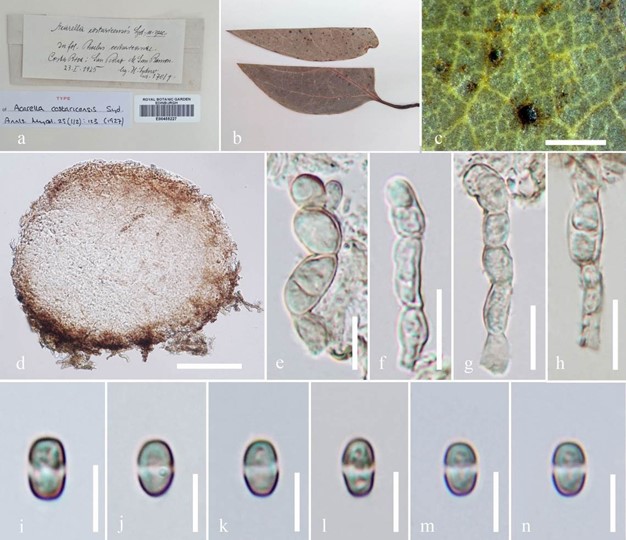Acarella costaricensis Syd. Annls mycol. 25(1/2): 123 (1927) Fig. 25
MycoBank number: MB 262145; Index Fungorum number: IF 262145; Facesoffungi number: FoF 06207
Parasitic or epiphytic on the surface of living leaves of Phoebe costaricanus. Sexual morph: Undetermined. Asexual morph: Conidiomata 58–110 µm high × 36–130 µm diam., ( x = 20.5 × 4 µm, n = 10), pycnidial, hypophyllous, dark brown to black, superficial, in groups with irregular margins, sometimes sparsely scattered or not entirely distributed on surface of leaves. Conidiophores 11–26 µm high, 3–5 µm wide ( x = 20.5 × 4 µm, n = 10) straight or slightly curved, hyaline, reduced to conidiogenous cells. Conidiogenous cells phialidic or enteroblastic percurrent, cylindrical to elliptical, septate, rough and thick-walled. Conidia 5–6 × 2–3 µm ( x = 5 × 3 µm, n = 10), ellipsoidal to cylindrical, solitary, hyaline to olivaceous-brown, 1-septate, apparently with 2- guttules.
Material examined – COSTA RICA, Central America, San Pedro de San ramon, Provincia de San José on Phoebe costaricanus sp. (Lauraceae), 23 January 1925, H. Sydow (E00455227, holotype).
Economic significance – The genus Acarella consist of species with neotropical distribution and form stalked appressoria. They infect the host manifesting as dark brown spots on leaf surfaces (Hofmann 2009). There is no molecular data available for the taxon.

Figure 25 – Acarella costaricensis (E00455227, holotype). a–c Herbarium specimen and habit on leaf. d Section of conidioma. e–h Conidiogenous cells and conidiogenesis. i–n Conidia. Scale bars: c = 500 μm, d = 100 μm, e–h = 10 μm, i–n = 5 μm.
Species
